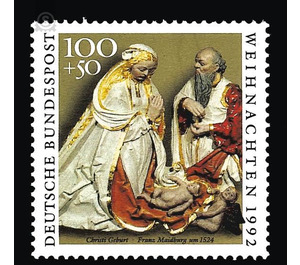Christmas - Germany / Federal Republic of Germany 1992 - 100 Pfennig
| Country | Germany / Federal Republic of Germany |
| Issue Date | 1992 |
| Face Value | 100.00 |
| Color | multi-colored brown |
| Perforation | K 13 3/4 |
| Printing Type | Multicolor offset printing |
| Stamp Type | Postage stamp |
| Item Type | Stamp |
| Chronological Issue Number | 1513 |
| Chronological Chapter | GER-BRD |
| SID | 785583 |
| In 36 Wishlists | |
This year's Christmas stamps show motifs from the works of Franz Maidburg in St. Anne's Church in Annaberg-Buchholz (Ore Mountains). The rich silver finds on Schreckenberg in 1492 and the associated rapid settlement of the area prompted the ruler Duke George of Saxony in 1496 to found the city of Annaberg, now Annaberg-Buchholz. In his custody was at the same time the 1499 begun church, which was consecrated to the mother of Mary and patron saint of miners, St. Anne. Under the appointed architect Konrad Pflüger, since 1481 site manager of Albrechtsburg in Meissen, and his successors Peter Ulrich von Pirna and Jakob von Schweinfurt, a student and employee of the Prague court architect Benedikt Ried, was built on the site of the previously built wooden church one of the most important hall churches in Upper Saxony , With the unity of the space and the dynamisation of the architectural individual forms as well as the vault, the leading design ideas of the late gothic architecture were realized in a grand way. In addition, the St. Anne's Church should receive a very rich architectural furniture. For this purpose, Jakob von Schweinfurt soon after taking over the site management in 1514 the Freiberger carver Franz Maidburg (Meydeburg, Magdeburg). No information has been received about the person and life of Maidburg, and even as an artist he can be understood for us alone in his works for St. Anne's Church. His hand features both the pulpit reliefs (c. 1516) and the lion heads (1518) on the rib ends of the then "New Sacristy", to whose portal he should have contributed as well. His design of the gallery parapet (1519-1524 / 25) may be considered new and unique in its scope. At the suggestion of the Duke, the otherwise customary parapet parapet is replaced by a relief cycle in porphyry tuff, containing 100 panels, which shows the faithful the salvation process in the style of the medieval picture Bible. He begins with the creation of the world, portrays the life of Mary, the life and passion of Christ as well as the martyrdom of the apostles and ends with the presentation of the Last Judgment. The salvation event is juxtaposed with 10 reliefs of the male and female ages, the human destiny of pride and transience. The last panel shows Jakob von Schweinfurt with a banner that records the beginning and completion of church construction (1499-1525). In the physiognomy of his figures, the relationship of body and robe as well as the wrinkling is clearly evident in the documentary witnessed Freiberg training Maidburg. In the composition of biblical scenes, on the other hand, the master frequently resorts to graphic models, v. a. Albrecht Dürers and Lucas Cranachs d. Ä., Back; a procedure that is certainly due to the wishes of the client and the scope of the order. However, a clear simplification of narrative structures can be seen in comparison to the templates; yes, the narrative moment of the multi-figure scenes returns in favor of an almost devotional concentration on salvation history content. In this sense Maidburg draws on the image tradition of the late 14th and early 15th centuries in the representation of the "Nativity", which had developed from the mystical writings of the time. Mary and Joseph are immersed in silent adoration of the child, whose divine light far outshines the glow of the candle that Joseph holds in her hands. The stance and gaze of the small winged angelic figure at the feet of the group is for the believer and also calls him to devout contemplation of the mystery of Christ's incarnation. A corresponding task is assigned to the king who looks out of the picture in the "Adoration of the Magi". Extracted from the historical context described by Dürer's woodcut from 1511, the depiction of the relief of the galleries becomes a symbol of worship. Special importance came in the late Middle Ages to the precious painting of the panels. The restoration in the years 1975-1989 exposed the original, polychrome version as well as partial gilding and supplemented flaws, so that today's viewer is given the impression of the original, magnificent effect of Franz Maidburg's main work. (Text: Petra Dietz M.A., Bonn)


